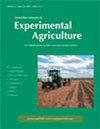Effectiveness of non-steroidal anti-inflammatory drugs and epidural anaesthesia in reducing the pain and stress responses to a surgical husbandry procedure (mulesing) in sheep
引用次数: 13
Abstract
In this study, we examined the potential of several widely used non-steroidal anti-inflammatory drugs (NSAIDs) and other analgesics to reduce pain and stress in sheep after surgery. Because mulesing involves a greater degree of tissue trauma than other surgical husbandry procedures such as castration or tail-docking, it provides a more rigorous and conservative test to identify potentially useful analgesic strategies in sheep. Merino lambs (5 weeks of age) were randomised into eight treatment groups: (1) carprofen; (2) flunixin; (3) ketoprofen; (4) buprenorphine; (5) xylazine; (6) lignocaine epidural; (7) saline control; (8) sham control. The NSAIDs were administered 1.5 h before mulesing, buprenorphine 0.75 h and xylazine and lignocaine 0.25 h before mulesing. Pain- and discomfort-related behaviours were recorded for 12 h after mulesing, and plasma cortisol concentrations were measured before mulesing and 0.5, 6, 12, 24 and 48 h after mulesing. The results indicated that no single analgesic treatment provided satisfactory analgesia during both the surgical mulesing procedure and the ensuing period of pain associated with the inflammatory phase. However, there were indications that two NSAIDs (carprofen and flunixin) showed good potential as analgesics during the inflammatory phase. A combination of short- and long-acting analgesics may be needed to provide more complete pain relief. In conclusion, the administration of some NSAIDs offers the potential for good analgesia in sheep for the inflammatory phase following the tissue trauma of surgical husbandry procedures. Other analgesic options need to be considered if the acute stress response to the procedure is to be reduced.非甾体类抗炎药和硬膜外麻醉在减轻绵羊外科饲养过程(除鼠)的疼痛和应激反应中的有效性
在这项研究中,我们研究了几种广泛使用的非甾体抗炎药(NSAIDs)和其他镇痛药在绵羊手术后减轻疼痛和应激的潜力。由于除骡比阉割或割尾等其他外科饲养过程涉及更大程度的组织损伤,因此它提供了一种更严格和保守的测试,以确定潜在有用的绵羊镇痛策略。将5周龄的美利奴羔羊随机分为8个治疗组:(1)卡洛芬;(2)氟尼辛;(3) ketoprofen;(4)丁丙诺啡;(5)甲苯噻嗪;(6)硬膜外麻醉;(7)生理盐水对照;(8)假性控制。取鼠前1.5 h给予非甾体抗炎药,取鼠前0.75 h给予丁丙诺啡,取鼠前0.25 h给予噻嗪和木多卡因。在取鼠后12小时记录疼痛和不适相关行为,并在取鼠前和取鼠后0.5、6、12、24和48小时测量血浆皮质醇浓度。结果表明,在手术切除过程和随后与炎症期相关的疼痛期间,没有一种镇痛治疗能提供满意的镇痛效果。然而,有迹象表明,两种非甾体抗炎药(卡洛芬和氟尼辛)在炎症期表现出良好的镇痛潜力。短期和长效镇痛药的组合可能需要提供更完全的疼痛缓解。综上所述,一些非甾体抗炎药的施用为外科饲养过程中组织损伤后炎症期的绵羊提供了良好的镇痛潜力。如果要减少对手术的急性应激反应,则需要考虑其他镇痛选择。
本文章由计算机程序翻译,如有差异,请以英文原文为准。
求助全文
约1分钟内获得全文
求助全文

 求助内容:
求助内容: 应助结果提醒方式:
应助结果提醒方式:


